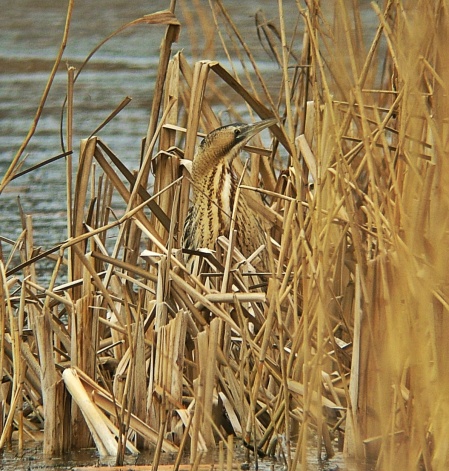It’s easy to imagine why some birds appeal so well to our myth-conjuring habits. I think particularly of those species that make a skill of obscurity. Crepuscular birds excel in shadow—the nightjar or woodcock are no more than ghostly silhouettes in dusk-dark. By day you’ve not a chance—their plumage is the very stuff of earth, intricate and cryptic patterns of leaf-litter, mulch, soil.
The bird that most comes to mind for these evasive sleights, though, is the bittern. It does not need darkness; this bird has perfected invisibility in specialist reed bed living. The woodcock’s argillaceous plumage is matched in the bittern by habitat imitation so effective it is remarkable no origin myths have passed down to tell of how the bird sheared from reed in metamorphosis, ripped up from the very same material in which it skulks. It’s colour and striations mimic the close, vertical world of marsh and fen exactly, especially so when the bird lifts its beak right up, narrows itself to reed-thinness and sways gently with the wind-rustling stems.

A well-camouflaged bittern. Image: Wikipedia Commons.
This morning I’ve been waiting since dawn at Ham Wall RSPB reserve for the briefest of glimpses. It’s April and I can hear one male booming—a sonorous, eerie bass note that carries over a mile. It’s this aspect of the bird, in fact, that humans have responded to for millennia. The many dialect terms for the bittern show alliterative playfulness with the bird’s reverberations: butter bump, bog bumper, bog blutter. These marvellous names go way back. In the Anglo-Saxon age, when King Alfred was hiding out here on the swampy Levels, the bird was a raredumle, probably meaning something like ‘reed-boomer’. By the late Middle Ages, the vernacular term was miredromble, but the English language also adopted French bitour, which became ‘bittern’. The strange booming spurred inventive explanations about how ‘a bitore bombleth in the myre’ by lowering its head ‘unto the water doun’ (Chaucer), or blowing through a reed. Inevitably, the supernatural aspect of the disembodied noise associated it with omen and disaster.

Image: RSPB
The old names alert us to the priority given to bird sound in the past, and even now the bittern is certainly a bird more encountered by its unique call than sight. Its presence in the once extensive marshes of Britain bred inventive myths down the centuries. Here on the Levels, bitterns stalked the prehistoric swamps alongside pelicans, cranes and white-tailed eagles. Neolithic tracks across the marsh still exist, preserved in peat beneath the watery landscapes recreated in recent years. What did our prehistoric ancestors make of the bittern’s booming call? What was their word for the bird? We’ll never know, but surely they were equally struck by its eldritch presence. Perhaps those medieval myths and names reach back this far.
Like many of Britain’s fen and marshland birds, the bittern became extinct. It recolonised in the early twentieth century after an absence of 50 years, but numbers remained low and as recently as 1997 there were only 11 booming males. Thanks to hard conservation work, 46 males have been estimated calling on the Avalon Marshes this spring in Somerset alone, the densest population anywhere in the country. Our names and myths recall how elemental bitterns are to this habitat, as much as reed and peat and water. It is joyously encouraging that a bird so intimately rooted in these special places is not lost.

RSPB Ham Wall reserve, April 2018

Very apt and evocative – and how nice to encounter the word ‘argillaceous’, though I would have guessed from its etymology that it conveyed a whiteness of some kind.
Jeremy
LikeLike
Fascinating account…I think I like ‘miredromble’ as a name best…I’m glad you had the Somerset experience this month.
Mum
LikeLike